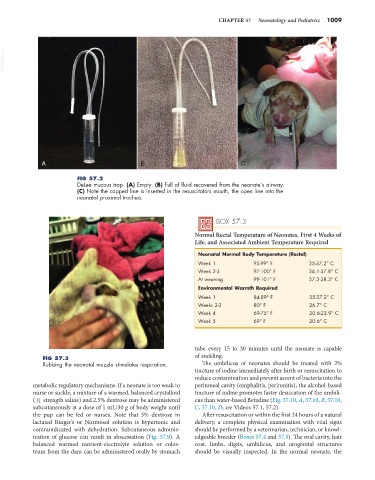Page 1037 - Small Animal Internal Medicine, 6th Edition
P. 1037
CHAPTER 57 Neonatology and Pediatrics 1009
VetBooks.ir
A B C
FIG 57.2
DeLee mucous trap. (A) Empty. (B) Full of fluid recovered from the neonate’s airway.
(C) Note the capped line is inserted in the resuscitators mouth, the open line into the
neonatal proximal trachea.
BOX 57.3
Normal Rectal Temperature of Neonates, First 4 Weeks of
Life, and Associated Ambient Temperature Required
Neonatal Normal Body Temperature (Rectal)
Week 1 95-99° F 35-37.2° C
Week 2-3 97-100° F 36.1-37.8° C
At weaning 99-101° F 37.2-38.3° C
Environmental Warmth Required
Week 1 84-89° F 35-37.2° C
Weeks 2-3 80° F 26.7° C
Week 4 69-75° F 20.6-23.9° C
Week 5 69° F 20.6° C
tube every 15 to 30 minutes until the neonate is capable
FIG 57.3 of suckling.
Rubbing the neonatal muzzle stimulates respiration. The umbilicus of neonates should be treated with 2%
tincture of iodine immediately after birth or resuscitation to
reduce contamination and prevent ascent of bacteria into the
metabolic regulatory mechanisms. If a neonate is too weak to peritoneal cavity (omphalitis, peritonitis); the alcohol-based
nurse or suckle, a mixture of a warmed, balanced crystalloid tincture of iodine promotes faster desiccation of the umbili-
( 1 2 strength saline) and 2.5% dextrose may be administered cus than water-based Betadine (Fig. 57.10, A, 57.10, B, 57.10,
subcutaneously at a dose of 1 mL/30 g of body weight until C, 57.10, D; see Videos 57.1, 57.2).
the pup can be fed or nurses. Note that 5% dextrose in After resuscitation or within the first 24 hours of a natural
lactated Ringer’s or Normosol solution is hypertonic and delivery, a complete physical examination with vital signs
contraindicated with dehydration. Subcutaneous adminis- should be performed by a veterinarian, technician, or knowl-
tration of glucose can result in abscessation (Fig. 57.9). A edgeable breeder (Boxes 57.4 and 57.5). The oral cavity, hair
balanced warmed nutrient-electrolyte solution or colos- coat, limbs, digits, umbilicus, and urogenital structures
trum from the dam can be administered orally by stomach should be visually inspected. In the normal neonate, the

